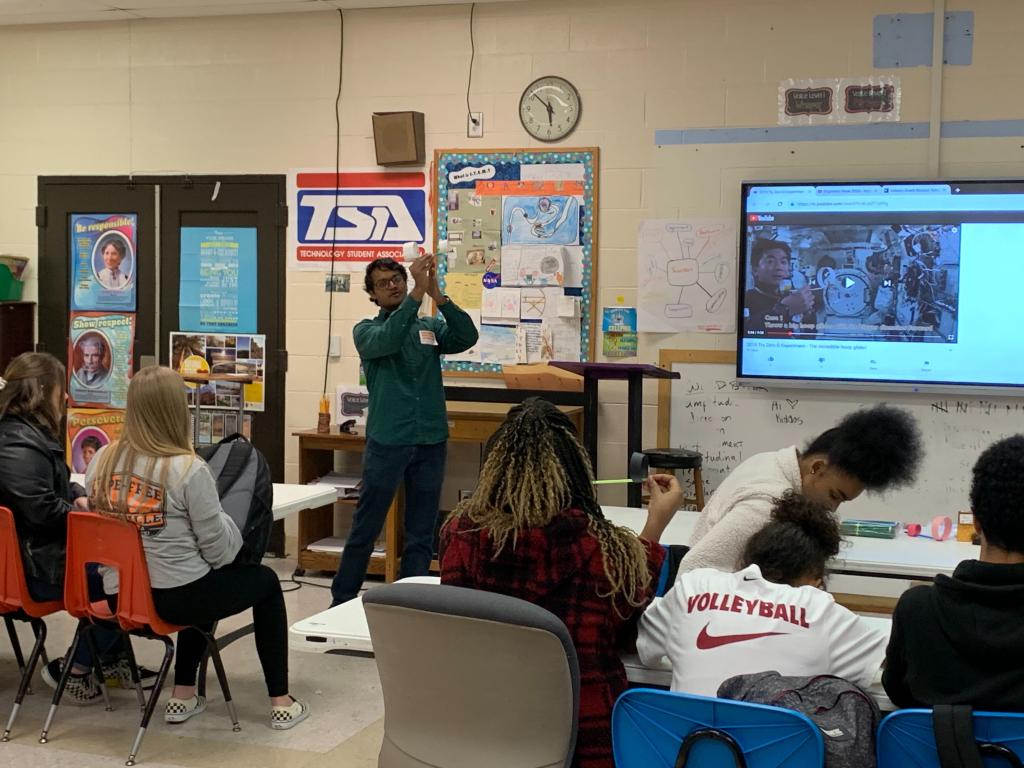ORNL takes engineering to the classroom for Engineers Week

OAK RIDGE, Tenn., Mar. 9, 2020 – “Engineering is about building things to help others.”
Before diving into a longer explanation, that’s how Singanallur “Venkat” Venkatakrishnan, an electrical and computer engineer at the Department of Energy’s Oak Ridge National Laboratory, described engineering to students at Northwest Middle School.
Venkat was among 20 ORNL engineers who visited 15 middle schools across East Tennessee for Engineers Week, an international outreach effort created to cultivate a diverse engineering workforce by “increasing understanding of and interest in engineering and technology careers.” ORNL’s inaugural Engineers Week activities introduced more than 800 students to the possibilities of engineering – and to the national lab in their backyard.
Though 84% of educators say a visit from an engineer helps students learn about engineering careers, according to the engineering outreach organization DiscoverE, 74% also say students don’t often get the opportunity to meet an engineer. ORNL focused this year’s effort on middle school, when many students aren’t sure what an engineer does.
After introducing the students to different fields of engineering – mechanical, civil, chemical, nuclear, computer and electrical engineering – Venkat described his own work in ORNL’s Electrical and Electronics Systems Research Division. At ORNL, he creates algorithms that help researchers transform data gleaned from neutrons and x-rays into crisp 3D images.
His work gives scientists a nondestructive way to study the structure and quality of materials, but he wanted to explain the broader impact of engineering as it relates to imaging.
Even with a ubiquitous cell phone camera, he told the students, “You have a device that can convert light into numbers, and when you store it in a computer that means you can do a lot. Each time you click a picture, the phone is actually doing algebra so it can store the picture and show it on the screen.”
Other everyday technologies – from airport security scanners to the popular photo messaging platform Snapchat – use mathematics and code to create clearer images, he continued.
“I didn’t really know much about engineering. I learned quite a bit,” said eighth grader Breanna Naysmith. “I thought it was cool that they used numbers to make the pictures clear.”
In addition to emphasizing hard skills required to be an engineer, such as math, physics and computer science, Venkat hit on soft skills, such as working on teams.
“At Oak Ridge National Laboratory, there are thousands of engineers who work together to create stuff,” he told the students. “In today’s world, that means being able to interact with a diverse set of people from different parts of the country and different parts of the world.”
Learning by doing
After his presentation, Venkat showed the students how to build a “hoop glider,” a small homemade aircraft similar to a paper airplane, using only paper, tape and plastic straws. The activity introduced students to the forces of flight. For Venkat, it had an additional purpose.
“My hope for them with that exercise was that they learned that some parts of engineering involve a little tinkering at first,” he said, smiling.
Multicolored gliders whizzing around the room didn’t make for too unusual of a scene in Tracy Anderson’s classroom. Her courses teach students at Northwest Middle about general science concepts, engineering design concepts and career opportunities in STEM fields, often through creative activities.
“In the STEM classes, we try to give them hands-on experiences to get them thinking and problem solving,” Anderson said.
But hearing firsthand from engineers like Venkat has a unique benefit: “These kids got a more realistic view of what an engineering job would be all about and what an engineer would do,” Anderson said. “We are very thankful that the ORNL engineers are willing to come out into the community and speak to students – because they are our future.”
Though he’s helped with ORNL’s Traveling Science Fair in the past, the experience was Venkat’s first time volunteering with students in a U.S. classroom.
“It was a lot of fun.” he said. “I would do it again if I get a chance. It was totally worth it, because they don’t get this opportunity all the time.”
A pile of thank-you notes
Another Engineers Week volunteer, ORNL’s Noah Carlson, started participating four years ago because he recognized the impact a few volunteers had in his early education and how that helped shape his future.
“When I was young, I had a couple people in my life that helped put me where I am today,” Carlson said, “so seeing early on the impact that people can have in a student’s life has been something that has stuck with me throughout my career.”
A structural engineer by training, Carlson works in ORNL’s Project Management Office. When he learned about Engineers Week, Carlson reached out to Oliver Springs Middle School, which he passes on his daily commute from his home in Morgan County. He first volunteered through a previous employer but continued the work independently after joining the lab.
In his presentations, Carlson teaches the students about structural engineering concepts by highlighting familiar landmarks in their community, such as Nemo Bridge, which is a popular swimming and kayaking spot in Morgan County.
After his first-ever Engineers Week, Noah walked away uncertain if his presentation had resonated with students – until the thank-you notes came pouring in.
“I probably have several hundred thank-you notes,” Carlson said. Lindsay Hagman, a teacher at Oliver Springs, says that she often hears students reference his visits years later.
“I see kids who say, ‘I can’t do this,’ and at the end of the class they say, ‘Oh, I did that,’” Carlson said of his classroom projects. “That realization is incredibly valuable for kids at a young age to be able to see they can put their mind to a problem and come up with a solution.”
“Definitely a highlight of my year,” he said.

